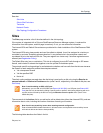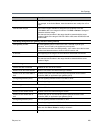
Site Topology
Polycom, Inc. 283
The RealPresence DMA system uses site topology information for a variety of purposes, including cascade
for bandwidth conferences, bandwidth management, Session Border Controller selection, and cluster
responsibility management in a supercluster. It can get it in one of two ways:
● If you have a Polycom RealPresence Resource Manager system, integrate the Polycom
RealPresence DMA system with it (see RealPresence Resource Manager Integration) to
automatically get its site topology information.
● If you don’t have a Polycom RealPresence Resource Manager system, enter site topology
information about your network directly into the Polycom RealPresence DMA system’s site topology
pages.
If your RealPresence DMA system is superclustered (see About Superclustering), site topology data only
needs to be created (or obtained from a RealPresence Resource Manager system) on one cluster of the
supercluster. It’s replicated across the supercluster.
For a conference with cascading for bandwidth enabled, the RealPresence DMA system uses the site
topology information to route calls to the nearest eligible MCU (based on pools and pool orders) that has
available capacity and to create the cascade links between MCUs.
When determining which MCU is “nearest” to a caller and which path is best for a cascade link, the system
takes into account the bandwidth availability and bit-rate limitations of alternative paths.
Bandwidth Management
Once you model a site topology to represent your physical network, you can use it to manage bandwidth
between your sites, preventing conference traffic from saturating the network.
Before the RealPresence DMA system routes a call, it considers the source and destination IP addresses
in the site topology and determines a media path from the source subnet to the destination subnet, taking
into account the existing calls and bandwidth restrictions along that path. If sites or site links have bandwidth
restrictions, the system reduces the call rate of the call at the time of call setup so that it meets those
restrictions, if possible. If the media path is already saturated with other conference traffic, the
RealPresence DMA system rejects the call attempt.
Note: Integration not supported in maximum security mode
Integration with a Polycom RealPresence Resource Manager system is not supported in Maximum
security mode.
Note: MCU Cascading considerations
Cascading for bandwidth uses a hub-and-spoke configuration so that each cascaded MCU is only one
link away from the “hub” MCU, which hosts the conference. The conference is hosted on the same
MCU that would have been chosen in the absence of cascading, using the pool order applicable to the
conference. See MCU Pool Orders.
The cascade links between MCUs must use H.323 signaling. For conferences with cascading
enabled, the Polycom RealPresence DMA system selects only MCUs that have H.323 signaling
enabled.
This cascade link requirement doesn’t affect endpoints, which may dial in using SIP (assuming the
MCUs and the Polycom RealPresence DMA system are also configured for SIP signaling).


















